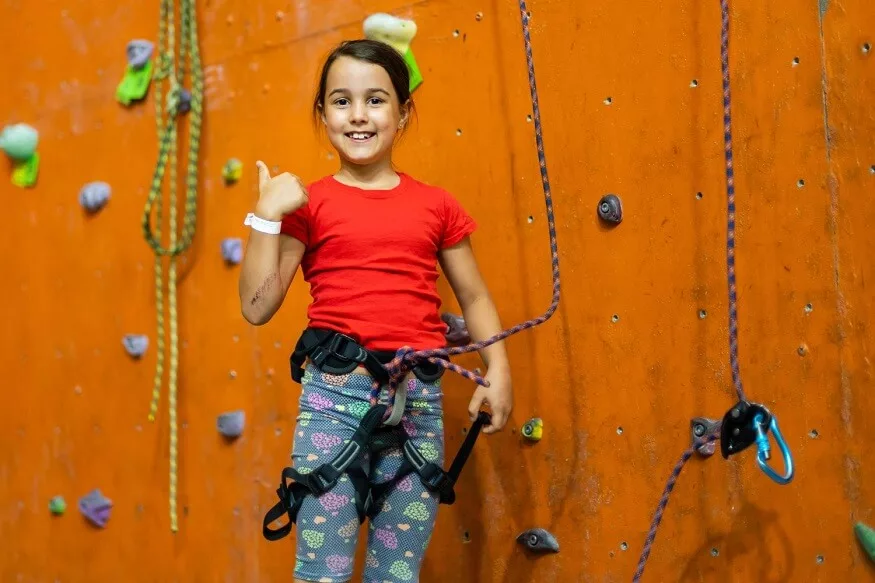Indoor rock climbing is a fun exercise that requires strength, agility, strategy, and skill. Anyone, young or old, fit or not, can enjoy the thrill of climbing higher.
This blog explores the exciting world of indoor rock climbing and its manifold benefits, underscoring why it could be your next must-try adventure.
Indoor rock-climbing basics
Indoor rock climbing is a thrilling sport that offers a structured environment where climbers can push their limits safely. The walls are studded with grips and footholds of varying shapes, mimicking the challenges one faces while climbing a natural rock surface.
The controlled environment is not only safe for beginners who are getting a feel of this unique form of exercise but also enables more experienced climbers to build upon their skills. The objective of indoor rock climbing is to complete the route by reaching the finish hold.
Also Read: Camping Activities for Kids Who Love Wildlife
Types of equipment for indoor rock climbing
- Climbing harness: A climbing harness is where the rope is connected, and it ensures the climber’s safety during ascents and descents. The harness wraps around the individual’s waist and legs providing a secure connection between the climber and the rope system.
- Climbing rope: The climbing rope is a strong cord that can bear a lot of weight and tension. It is directly linked to the climber’s harness and is there to catch them if they slip. In indoor climbing, the rope is anchored at the top of the wall to keep everyone safe.
- Climbing shoes: The specialised shoes have a rubber sole for traction. They have a very close fit, so one can dig into small climbing holds with their toes and get that much-needed grip.
- Helmet: A helmet is suggested for protection against potential head injuries.
- Chalk and chalk bag: Climbers use chalk to absorb sweat from their hands, improving their grip on the climbing holds.
The chalk bag is a small pouch worn around the waist, allowing easy access to chalk during climbing. The chalk is used to keep your hands dry when climbing. It is usually clipped onto the back of a climbing harness or is worn at the back of a waist belt.
- Belay device: The belay device controls the rope during the climbing and descending processes. It allows the belayer to catch a climber if they fall and lower climbers safely to the ground.
- Carabiners and quickdraws: A carabiner is an oval, D-shaped or pear-shaped loop of metal that has a spring-loaded gate on one side. It is used to connect various items of climbing gear.
Quickdraws are two non-locking carabiners joined together by a length of reinforced webbing. They are used to attach a rope to a bolt or piece of protection.
Also Read: 10 Best Extracurricular Activities for Kids
Types of indoor rock-climbing walls
- Top rope climbing
Here, a rope is ready at the top, and a belayer keeps the climber safe. It’s perfect for beginners, ensuring safety and allowing them to focus on improving without fear of falling.
- Bouldering
- Bouldering is a form of rock climbing performed without the use of ropes or harnesses. It is done on artificial rock walls, with a maximum height of around six meters.
- Falls are countered by crash pads, used to cushion any fall. This form of climbing is a favourite due to its simplicity and convenience, as it demands less equipment and can be done without a belayer.
- Bouldering encourages physical strength, endurance, and problem-solving skills, and it also provides a community environment since climbers can attempt problems together.
- Lead Climbing
Also known as sport climbing, lead climbing is a more advanced form of indoor climbing. In this mode, climbers carry the rope with them and clip it into pre-placed bolts along the route. Lead climbing is more challenging and exciting since it presents a real climbing experience, increasing both the physical and mental challenge.
Also Read: When Can Baby Climb Stairs and How Can You Keep Them Safe
Terms used in indoor rock climbing
- Routes/Problems: A route or a problem describes the predetermined path that a climber is supposed to take up the wall and is usually marked by holds of a specific colour or tape
- Belayer: This refers to the person on the ground who controls the rope’s tension to ensure the safety of the climber. A related term, “belaying,” refers to the system of ropes and anchors designed to catch a climber if they fall.
- Holds: They are the artificial hand and foot grips that climbers use to move upwards. These vary in size and shape to mimic natural rock features.
- Crimp is a small hold that can only be gripped with fingertips.
- Jug: a large hold that can be easily gripped, providing a solid rest point.
- Sloper: a hold with little or no edge to grip, requiring effective use of friction between the hand and the hold.
- Mantling: Different manoeuvres and positions that climbers adopt while climbing include mantling where climbers use their hand like a shelf to push themselves upward
- Smearing: This is where climbers press their shoes against the wall for friction when there are no footholds
- Heel hook: This is where the climbers hook their heel over a hold and use it to pull themselves up.
- Matching: Matching is a technique where you bring both your hands or feet to the same hold.
Benefits of indoor rock climbing
- Health benefits
Indoor rock climbing is a low-impact activity that engages the whole body. It drives the climber to use almost every muscle group, making it an excellent form of physical exercise. Besides enhancing muscle strength and endurance, it also improves flexibility, balance, and coordination. Climbers often find their core muscles tighten due to
- Mental benefits
Strategic route planning and quick decision-making in response to the challenges encountered during the climb make this activity a mental exercise as much as it is a physical one. It instilled a sense of accomplishment and self-confidence in climbers as they progress and reach new heights.
- Social benefits
It is also a social activity, fostering camaraderie and team spirit. Rock climbers often have to rely on their partners for belaying, which entails watching the rope, ensuring climber safety, and offering supportive encouragement. This shared experience of adventure, trust-building, and accomplishment contributes to building a positive community.
Also Read: Guide to Mountain Trekking for children: Everything You Need to Know
Indoor rock climbing is an adventurous sport that appeals to a wide demographic. It provides not just a thorough workout but also a chance to build mental resilience, teamwork, personal courage, and a sense of achievement. So, don your climbing shoes and conquer your fears; grab hold of determination, and strength, and explore the adventures of indoor rock climbing.










